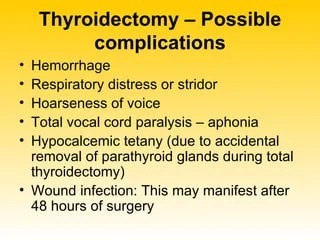While caring for a client one day following a thyroidectomy, the practical nurse (PN) notes that the client's voice is hoarse. What action should the PN take?
Notify the unit charge nurse of the finding.
Administer humidified oxygen per nasal cannula.
Obtain a cup of ice chips for the client.
Ensure that the drainage device is compressed.
The Correct Answer is A
Hoarseness or voice changes after thyroidectomy can be indicative of injury or irritation to the recurrent laryngeal nerve, which is responsible for controlling the vocal cords. This is a potential complication of the surgery and should be reported to the charge nurse or healthcare provider for further evaluation and management.

B. Administer humidified oxygen per nasal cannula: This option is not appropriate for addressing hoarseness in a client following a thyroidectomy. Hoarseness after a thyroidectomy is typically related to vocal cord injury or irritation, and providing humidified oxygen would not directly address this issue. It is important to notify the charge nurse or healthcare provider for further evaluation and management.
C. Obtain a cup of ice chips for the client: Providing ice chips is not the appropriate action for hoarseness following a thyroidectomy. Ice chips are typically used to provide hydration and comfort to clients, but they do not directly address the underlying cause of hoarseness, which in this case may be vocal cord injury or irritation. It is important to notify the charge nurse or healthcare provider for appropriate evaluation and management.
D. Ensure that the drainage device is compressed: While ensuring proper compression of a drainage device is important for preventing complications such as bleeding or infection, it is not directly related to the client's hoarseness. Hoarseness after a thyroidectomy is more likely related to vocal cord injury or irritation, and notifying the charge nurse or healthcare provider is necessary for further assessment and management.
Nursing Test Bank
Naxlex Comprehensive Predictor Exams
Related Questions
Correct Answer is C
Explanation
A callus is a normal response of the body during bone healing, where new bone tissue forms around the fracture site to provide stability and support. It helps in the process of bridging the fracture and promoting healing.
The PN can provide reassurance to the client by explaining that the presence of a callus indicates that the bone is healing and progressing toward recovery. It is important to educate the client about the expected timeline for bone healing and the need for continued follow-up with the healthcare provider.
Incorrect:
A. Prepare to assist in applying a new cast to reduce pressure points: This choice assumes that the client's concern is related to discomfort or pressure points caused by the current cast.
However, the client's concern is about the formation of a callus, which is a normal part of bone healing. There is no indication that a new cast is necessary at this point.
B. Report the client's concern to the healthcare provider: While it's important to address client concerns and communicate any changes in their condition to the healthcare provider, in this case, the formation of a callus is an expected part of the bone healing process. It is not necessary to report this concern to the healthcare provider as it is a normal occurrence.
D. Teach the client strategies to prevent further calluses: The formation of a callus in this context is a natural response of the body to promote bone healing. It is not necessary to teach the client strategies to prevent further calluses, as callus formation is a temporary and beneficial part of the healing process.
Correct Answer is A
Explanation
This is the correct answer, as it reflects the nurse's assessment of the injury and the appropriate action to take. The nurse should consider the mother's report of pain as a valid indicator of the severity of the injury, and should not dismiss or minimize it. The nurse should also observe the boy's arm and shoulder for any signs of fracture, dislocation, swelling, bruising, or deformity, and ask him to rate his pain on a scale of 0 to 10. The nurse should then decide whether to refer the boy to a physician or an emergency department for further evaluation and treatment.
Whether you are a student looking to ace your exams or a practicing nurse seeking to enhance your expertise , our nursing education contents will empower you with the confidence and competence to make a difference in the lives of patients and become a respected leader in the healthcare field.
Visit Naxlex, invest in your future and unlock endless possibilities with our unparalleled nursing education contents today
Report Wrong Answer on the Current Question
Do you disagree with the answer? If yes, what is your expected answer? Explain.
Kindly be descriptive with the issue you are facing.
